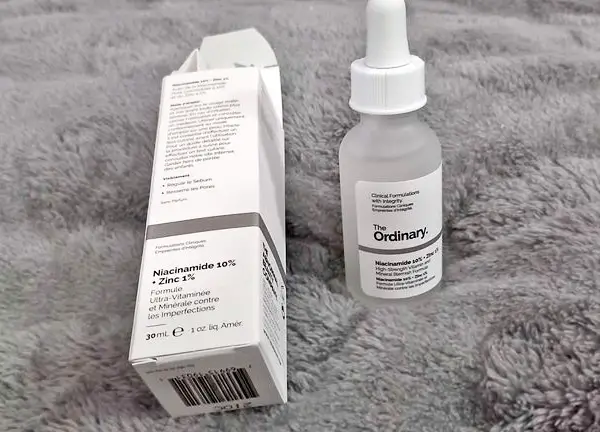Perioral dermatitis, a common skin condition that causes a red, bumpy rash around the mouth, can be frustrating and difficult to treat. But there is hope! Niacinamide, a form of vitamin B3, is a gentle yet effective ingredient that can help to soothe inflammation, reduce redness, and improve the overall appearance of perioral dermatitis.
This blog post will discuss the benefits of niacinamide for perioral dermatitis, as well as how to choose and use niacinamide products effectively.

What is Niacinamide?
Niacinamide, also known as nicotinamide, is a water-soluble form of vitamin B3. It is an essential nutrient that plays a crucial role in various bodily functions, including energy production, cell signaling, and DNA repair. In the realm of skincare, niacinamide has emerged as a versatile and effective ingredient, gaining popularity for its diverse range of benefits.
Role in Skin Health
Niacinamide plays a vital role in maintaining healthy skin. It contributes to the production of keratin, a protein that provides strength and elasticity to the skin. Additionally, niacinamide enhances the skin’s barrier function, helping to retain moisture and protect against environmental aggressors.
Diverse Benefits
Niacinamide offers a myriad of benefits for skin health. Its anti-inflammatory properties make it an effective treatment for acne, rosacea, and eczema. As an antioxidant, it helps combat free radicals, reducing oxidative stress and protecting the skin from premature aging. Niacinamide also promotes collagen synthesis, contributing to skin firmness and elasticity.
Overall, niacinamide is a versatile and effective skincare ingredient that has gained widespread recognition for its ability to address a range of skin concerns, making it a valuable addition to any skincare routine.
Benefits of Niacinamide for Perioral Dermatitis
Perioral dermatitis, a common inflammatory skin condition, is characterized by a red, bumpy rash around the mouth. While the exact cause of perioral dermatitis remains unclear, it is often associated with factors such as topical steroid use, stress, and genetics.
Niacinamide has emerged as a promising treatment option for perioral dermatitis due to its well-documented anti-inflammatory and skin-soothing properties. It may help to alleviate several symptoms of perioral dermatitis, including:
Reducing Redness: Niacinamide’s anti-inflammatory properties help calm the skin, reducing the redness and flushing associated with perioral dermatitis.
Soothing Inflammation: Niacinamide’s ability to modulate inflammatory pathways helps reduce the inflammation that underlies perioral dermatitis, leading to a calmer and less irritated complexion.
Diminishing Bumps: Niacinamide’s anti-inflammatory and skin-regulating properties can help reduce the appearance of bumps and pustules associated with perioral dermatitis, promoting a smoother skin texture.
Supporting Skin Barrier Function: Niacinamide strengthens the skin barrier, enhancing its ability to retain moisture and protect against environmental irritants, which can aggravate perioral dermatitis.
Scientific Evidence
While the research specifically targeting niacinamide’s effects on perioral dermatitis is still evolving, several studies have highlighted its benefits in treating similar inflammatory skin conditions. This indirect evidence suggests that niacinamide could be a valuable ally in managing perioral dermatitis.
A comprehensive review titled “Cosmeceutical Aptitudes of Niacinamide,” published in “Recent Advances in Antiinfective Drug Discovery,” provides further insights into the diverse applications of niacinamide in dermatology, relevant to conditions like perioral dermatitis:
- Wide-Ranging Dermatological Applications: The review underscores niacinamide’s effectiveness across various skin disorders, including aging, hyperpigmentation, acne, psoriasis, pruritus, dermatitis, and fungal infections. Its ability to treat these conditions, which share common inflammatory pathways with perioral dermatitis, reinforces its potential as a treatment option.
- Multifaceted Skin Benefits: Niacinamide is recognized for its anti-inflammatory, antimicrobial, antioxidant, antipruritic, and anticancer properties. These properties are crucial in managing the symptoms of perioral dermatitis, particularly inflammation and skin barrier dysfunction.
- Promoting Skin Health and Regeneration: The review also highlights the long-term benefits of niacinamide for skin health. Its role in promoting new skin cell growth leads to healthier, more resilient skin, which is particularly beneficial for managing perioral dermatitis.
Choosing Niacinamide Products for Perioral Dermatitis
When selecting niacinamide products for perioral dermatitis, it is crucial to consider both the concentration and formulation of the product. Here are some key guidelines to follow:
- Concentration: Niacinamide is generally considered safe and well-tolerated at concentrations of up to 10%. However, for perioral dermatitis, it is recommended to start with a lower concentration of 2-5% and gradually increase it as your skin tolerates it. This approach allows the skin to adjust to the ingredient and minimizes the risk of irritation.
- Formulation: The formulation of the niacinamide product plays a significant role in its efficacy and potential for irritation. Opt for products that have a soothing, non-comedogenic base. Avoid products containing fragrance, alcohol, or other known irritants that could aggravate perioral dermatitis.
Using Niacinamide Products Effectively for Perioral Dermatitis
Niacinamide is a versatile skincare ingredient that can be effectively incorporated into a skincare routine for perioral dermatitis. Here are some clear instructions on how to use niacinamide products effectively:
Start with a Low Concentration and Gradually Increase
Begin with a low concentration of niacinamide, such as 2-5%, to allow your skin to adjust to the ingredient. As your skin tolerates the lower concentration, you can gradually increase it to reach the desired level of efficacy.
Patch Test Before Use
Before incorporating any new skincare product into your routine, including niacinamide, perform a patch test on a small area of skin, such as the inside of your elbow. This helps identify any potential skin reactions or allergies.
Incorporate Niacinamide into Your Skincare Routine
Niacinamide can be used either in the morning or evening skincare routine. However, it is generally recommended to use it in the evening, as it can enhance the skin’s barrier function and protect against environmental aggressors during sleep.
Gentle Cleansing
Start your skincare routine by cleansing your face with a gentle, fragrance-free cleanser. Avoid harsh cleansers that can strip away natural oils and further irritate the skin.
Apply Niacinamide Serum or Moisturizer
After cleansing, apply your niacinamide-containing product, either a serum or moisturizer. Apply a pea-sized amount to your face and neck, avoiding the eye area. Although niacinamide can be layered with other skincare ingredients, it’s best to avoid combining it with high concentrations of vitamin C, as this can reduce its efficacy.
Moisturize Regularly
Perioral dermatitis can cause dryness, so it is essential to moisturize regularly. Choose a fragrance-free, non-comedogenic moisturizer to avoid irritation.
Sun Protection
While niacinamide does not increase skin sensitivity to sunlight and, in fact, can help protect against UV damage, using a broad-spectrum sunscreen with an SPF of 30 or higher is still crucial. Sunscreen is an essential part of any skincare routine, especially for those dealing with skin conditions like perioral dermatitis. It helps protect the skin from further damage and irritation caused by UV rays.
Be Patient and Consistent
Niacinamide takes time to show its full effects. Be patient and consistent with your skincare routine for noticeable results.
Conclusion
Niacinamide stands out as a gentle yet powerful ingredient in the fight against perioral dermatitis. Its anti-inflammatory, skin barrier-strengthening, and overall skin-soothing properties make it a suitable option for those seeking a non-irritating treatment.
As with any skincare treatment, it’s important to consult with a dermatologist to tailor a regimen that’s right for your specific skin needs. With the right approach, niacinamide can be a valuable addition to your skincare arsenal in managing perioral dermatitis.

